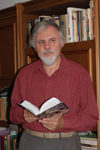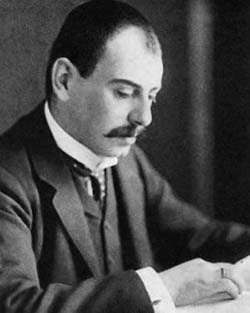By Alex Gordon


HAIFA, Israel — Edmund Georg Hermann (Yehezkel) Landau was born on February 14, 1877 into the family of a successful Berlin Jewish gynecologist, Professor Leopold Landau. His mother Johanna came from the famous Jacobi banking house. Until the age of 16, Edmund attended the Collège Français (French Gymnasium) in Berlin, from which he successfully graduated two years early. He studied mathematics at the universities of Berlin and Munich (1893-1895), receiving his doctorate in 1899 (University of Berlin). From 1901-1909 he was privat-docent, then professor at the University of Berlin, and in 1909-1934 he was professor at the University of Göttingen.
In 1905 he married Marianne Ehrlich, daughter of Nobel laureate Paul Ehrlich.
His main areas of research were function theory and analytic number theory. Landau became world famous for his two-volume course Foundations of Analysis (1930), written with impeccable logical rigor. As a professor he enjoyed great success, doctoral students came to him from all over the world.
Thanks to the means of his parents and his wife’s father Paul Ehrlich, Landau was a wealthy man. In Göttingen, he built himself a mansion, where he placed a huge scientific library. He had two hobbies: in his spare time, he read detective novels with great enthusiasm, and he also had an extensive and valuable stamp collection, which he regularly added to.
In April 1925, Landau spoke at the groundbreaking ceremony for the Wattenberg Building of the future Hebrew University of Jerusalem: “Here in Jerusalem we are just founding a university today, and we can lay a common cornerstone for a building where the two sciences [he meant mathematics and physics.] which have so many points of contact will be cultivated. As for mathematics itself: it is well known how formidable a role Jews of the European countries played in the development of this science. It is my wish and hope that from among the walls of the building we are founding today, Jewry will continue to impart upon mankind many deserving gifts in the form of discoveries and inventions that will be important for fundamental research and valuable in practice. May great benefit emerge from this house dedicated to pure science, which does not know borders between men and people. And may this awareness emerge from Zion and penetrate the hearts of all those who are still far from this view.”
In 1927 Landau was invited to lecture at the Hebrew University in Jerusalem. The German-Israeli mathematician Abraham Fränkel, in Recollections of a Jewish Mathematician in Germany, wrote: “Although he was not brought up in the Jewish tradition, much less in religion, in his characteristic energetic manner he began to learn Hebrew and learned it surprisingly quickly, in particular, he became fluent in it. And in the fall of 1927, he went to Jerusalem as the first professor of mathematics at the Hebrew University. Landau successfully taught the enthusiastic students for one semester. […] In those years I became especially close to Landau, one of the reasons for this rapprochement being his enthusiasm for and success in Hebrew. He even sent me telegrams in Hebrew from Göttingen to Marburg! My last meeting with Landau took place in Switzerland shortly after the Nazis came to power. Unlike Courant, he was not frightened, rather, on the contrary, he was filled with incomprehensible optimism. But the blow came soon after – even sooner than other Jewish professors. Göttingen students, clearly incited from above, protested against him and demanded his resignation.”
The reasons for the “revolt” against Landau are explained by the antisemitic speech against him by the Berlin mathematics professor Ludwig Biberbach, who was apparently the author of the concept of “Aryan” and “Jewish” mathematics. In a lecture given in the spring of 1934, Bieberbach said: “The behavior of the Göttingen students toward Edmund Landau is quite reasonable and justified, since Landau’s case clearly shows that there is German mathematics and there is Jewish mathematics – two worlds separated by an insurmountable gulf. The choice of scientific problems and the approach to them are dictated by the scientist himself and are therefore a product of his race. […] A nation that has found its own face cannot tolerate such teachers and must reject alien thought.”
The press – the journal Deutsche Zukunft (German Future) of April 8, 1934 and Forschungen und Fortschritte (Research and Progress) of June 20, 1934 – covered the lecture extensively. Frenkel in his book describes Biberbach’s lecture as follows: “Biberbach further refers to the psychological typology of [Nazi sympathizer] Erich Jaensch, identifying the abstraction-seeking Type S with Jews and speakers of Romance languages, and Type J, which seeks to grasp reality in all its diversity, with Germans.”” Biberbach said: “The abstract Jewish thinkers of Type S knew how to distort [Hilbert’s axiomatics] in order to use it as an intellectual variety show. […] This is a typical example of how racially alien influences and racially alien temptations cut Germans off from the source of their own power. […] There is no self-sufficient mathematical field that is independent of ideology and life; the debate about foundations that is now unfolding is really a debate about race. […] In the final analysis, this juggling of concepts and outright subterfuge is characteristic of an inorganic, hostile to us type S, especially of Jewish mathematics.”
The journal German Future concluded, “From the point of view of practical cultural policy, it turns out that mathematics is not subject to the curse of sterile intellectualism; its burden falls on those thinkers who are alien to nation and race, who have no place in the future and who belong to the past and can no longer bear the name of German scientist. German mathematics is rooted in blood and soil.”
Landau and all Jewish mathematicians were dismissed by the Nazis from the University of Göttingen. In a letter to Biberbach, dated May 19, 1934, one of the greatest American mathematicians, Oswald Veblen, a professor at the Institute for Advanced Study in Princeton, expressed disgust at the distinction between Jewish and German mathematics and at the pseudoscientific justification for the harassment of Landau, “one of the great mathematicians of our era.” He added that the article in German Futures in the United States was read “with a mixture of regret, derision and contempt.”
After losing his professorship at Göttingen, Landau moved to Berlin. From 1935 he taught at the University of Cambridge, and in 1937-1938 at the University of Brussels. He died on February 19, 1938 at his Berlin home of a heart attack at the age of 61.
*
Alex Gordon is professor emeritus of physics at the University of Haifa and at Oranim, the academic college of education, and the author of 10 books.